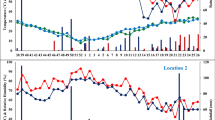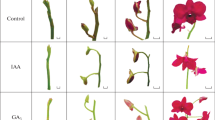Abstract
Podophyllum hexandrum Royle, an important alpine herb, is the source of highly valued podophyllotoxin. The effect of some plant growth substances (GA3, BAP & ABA), uniconazole (an inhibitor of GA biosynthesis), and a combination of GA3 and uniconazole were examined in respect to influence on sprouting in rhizomes of P. hexandrum and on induction of flowering at a lower altitude. Amongst the various chemicals tested, GA3 had a marked effect resulting in uniform sprouting and also induced flowering in about half of the treated rhizomes. While BAP also promoted early sprouting, delayed sprouting was seen in rhizomes treated with ABA. Uniconazole treatment, either alone or with GA3 was found to inhibit flowering and also resulted in reduced plant height. GA3 treatment of rhizomes from plants that was maintained for up to 30 months at a lower altitude also induced flowering thus replacing the normal chilling requirement of plants. These results suggest that treatment of GA3 could be effectively used for inducing uniform sprouting and flowering in rhizomes of P. hexandrum grown at lower altitudes.
Similar content being viewed by others
Abbreviations
- ABA:
-
abscisic acid
- BAP:
-
6-benzylaminopurine
- GA3 :
-
gibberellic acid
References
Airi S., Rawal R.S., Dhar U., Purohit A.N. 1997. Population studies on Podophyllum hexandrum Royle — a dwindling, medicinal plant of the Himalaya. Plant Genet. Resour. Newslett. 110: 29–34.
Anonymous. 1988. The wealth of India: A dictionary of Indian raw materials and industrial products (Publication and Information Directorate, CSIR, New Delhi), vol III: Ph-Re, 170–174.
Bernier G. 1988. The control of floral evocation and morphogenesis. Annu. Rev. Plant Physiol. 39: 175–219.
Bhadula S.K., Singh A., Lata H., Kuniyal C.P., Purohit A.N. 1996. Genetic resources of Podophyllum hexandrum Royle, an endangered medicinal species from Garhwal Himalaya, India. Plant Genet. Resour. Newslett. 106: 26–29.
Fay D.A., Ziegler H.W. 1985. Botanical source differentiation of Podophyllum resin by high performance liquid chromatography. J. Liq. Chromatogr. 8: 1501–1506.
Katsura N., Takayanagi K., Sato T., Nishijima T., Yamaji H. 1991. Gibberellin — induced flowering and morphological changes in Taro plants. In: Gibberellins, ed. by N. Takahashi, B.O. Phinney, J. MacMillan, Springer Verlag, Berlin, 370–377.
Kala C.P., Rawat G.S., Uniyal V.K. 1998. Ecology and conservation of the valley of flowers national park, Garhwal Himalaya, A report published by Wildlife Institute of India, Dehradun, 99 p.
Kumar A., Palni L.M.S., Nagar P.K., Gupta A.K. 2001. Changes in endogenous abscisic acid and phenols in Gladiolus cormels in relation to storage and dormancy. Physiol. Mol. Biol. Plants 7: 67–74.
Kuo C.G. 1991. Prospect for gibberellins control of vegetable production in the tropics. In: Gibberellins, ed. by N. Takahashi, B.O. Phinney, J. MacMillan, Springer Verlag, Berlin, 361–369.
Lang A. 1965. Physiology of flower initiation. In: Encyclopedia of Plant Physiology, ed. by W. Ruhland, Springer Verlag, Berlin, 1380–1536.
Lurie G., Watad A.A., Borochov A. 1993. Acontum: effect of tuber size, day length and GA3 on growth, flowering and tuber production. Acta Hortic. 325: 113–117.
Mark H.F. 1970. Floral initiation and development in New Zealand alpine plants. N. Z. J. Bot. 81: 67–75.
Metzger J.D. 1995. Hormones and reproductive development. In: Plant Hormones, Physiology, Biochemistry and Molecular Biology, ed. by P.J. Davies, Kluwer Academic Publishers, Dordrecht, 2nd edition, 617–648.
Murashige T., Skoog F. 1962. A revised medium for rapid growth and bioassays with tobacco tissue cultures. Physiol. Plant. 15: 473–497.
Nadeem M., Palni L.M.S., Purohit A.N., Pandey H., Nadi S.K. 2000. Propagation and conservation of Podophyllum hexandrum Royle: An important medicinal herb. Biological Conser. 92: 121–129.
Naylor A. W. 1984. Functions of hormones at the organ level to organization. Hormonal regulation of development: The functions of hormones from the level of the cell to the whole plant. In: Encyclopedia of Plant Physiology, New series, vol. 10, ed. by T. K. Scott, Springer Verlag, Berlin, 172–208.
Nishijima T., Katsura N., Koshioka M., Yamazaki H., Mander L.N. 1997. Effect of uniconazole and GA3 on cold-induced stem elongation and flowering of Raphanus sativus L. Plant Grow. Regul. 21: 207–214.
Palni L.M.S., Nandi S.K., Singh S. 1990. Physiology and Biochemistry of Cytokinins. In: Hormonal regulation of plant growth and development, Vol. V, ed. by S.S. Purohit, Agro Botanical Publishers, Bikaner, India, 1–60.
Pandey H., Nandi S.K., Nadeem M., Palni L.M.S. 2000. Chemical stimulation of seed germination in Aconitum heterophyllum Wall. and A. balfourii Stapf: Important Himalayan species of medicinal value. Seed Sci. & Tech. 28: 39–48.
Pharis R.P., King R. 1985. Gibberellins and reproductive development in seed plants. Annu. Rev. Plant Physiol. 36: 517–568.
Pharis R.P. 1991. Physiology of gibberellins in relation to floral initiation and early floral differentiation. In: Gibberellins, ed. by N. Takahashi, B.O. Phinney, J. MacMillan, Springer Verlag, Berlin, 166–178.
Salisbury F.S. 1963. The flowering process: The low temperature promotion of flowering. Pergamon Press, Oxford, 45–71.
Samant S.S., Dhar U., Palni L.M.S. 1999. Medicinal plants of Himalaya: Distribution and Potential Values, Himvikas Publication, Gyanodaya Prakashan, Nainital, 163 p.
Sorce C., Piaggesi A., Ceccarelli N.N., Lorenzi R. 1996. Role and metabolism of abscisic acid on potato tuber dormancy and sprouting. J. Plant Physiol. 49: 548–552.
Spomer G.G. 1964. Physiological ecology studies of alpine cushion plants. Physiol. Plant. 17: 717–724.
Turnbull C.G.N., Hanke D.E. 1985. The control of bud dormancy in potato tubers. Evidence for the primary role of cytokinins and seasonal pattern of changing sensitivity to cytokinins. Planta 165: 359–365.
Van Uden W., Pras N., Visser J.F., Malingre Th M. 1989. Detection and identification of podophyllotoxin produced by cell cultures derived from Podophyllum hexandrum Royle. Plant Cell Rep. 8: 165–168.
Author information
Authors and Affiliations
Corresponding author
Rights and permissions
About this article
Cite this article
Pandey, H., Nandi, S.K., Chandra, B. et al. GA3 induced flowering in Podophyllum hexandrum Royle: A rare alpine medicinal herb. Acta Physiol Plant 23, 467–474 (2001). https://doi.org/10.1007/s11738-001-0057-2
Received:
Accepted:
Issue Date:
DOI: https://doi.org/10.1007/s11738-001-0057-2




